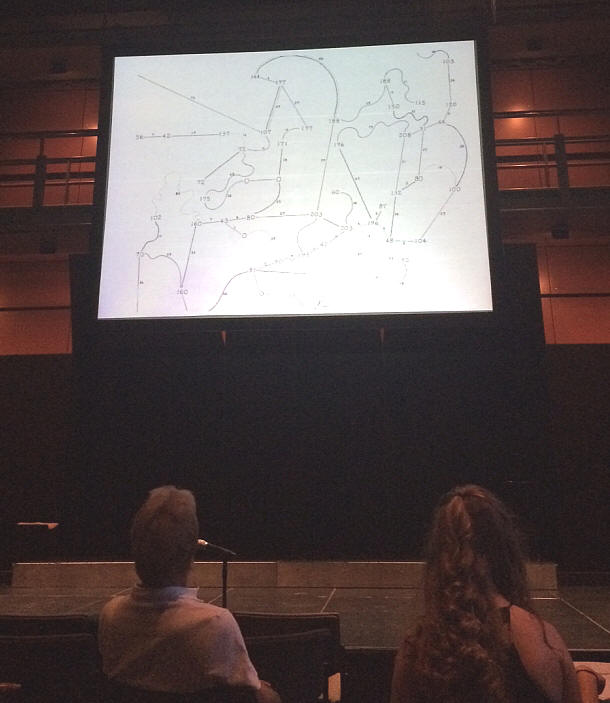
Concert Review
UC Davis Early Music Ensemble
Ear for EAR - June 1, 2016
I came expecting a concert, but this was more than a concert. Instead, Director Matilda Hofman crafted an experience for her audience. It was an early music experience, of course, but it had elements that went beyond what one might have expected for a concert of early choral music. I think Hofman’s introduction is very helpful in getting the proper perspective of this event:
“This program invites the audience to explore how we listen, and to listen in different ways. What do we listen to? At some points in the program we will move seamlessly from the twentieth-century John Cage to twelfth-century Hildegard Von Bingen. We also experiment with the use of space in the theater. Composers, both ancient and modern, have explored the use of space in music as a musical element, from the Cori Spezzati tradition of Gabrieli to the modern American experimentalists…. As Stockhausen wrote, ‘All the commentaries that have ever been, and those yet be written, all these thoughts and dreams and impressions and visions and actions which music arouses in its hearers, all these, no less, add up to the “meaning” of this music, something which must always remain largely a mystery, never totally to be comprehended by a single individual. The resonance is different in every person, for each stands on a different rung of the ladder of spiritual self-enhancement.’”
The performance was held in the Vanderhoef Studio Theatre at Mondavi Center, notable for the floor-to-ceiling windows along the right side of the room. The room itself was set with cocktail tables, four chairs to a table, each table covered in a black cloth. On some of the tables there were one or more small percussion instruments that I could not identify.
(Click here to open the concert program in a new window.)
The program began with Hofman introducing what she described as a “rather special program [that would explore] the outer limits of what we consider as music and how we listen to it.” She emphasized that the juxtaposition of the program’s elements would be significant, adding that it would begin with “one visible voice and many which are not visible.”
With that, Chris Castro entered the stage, taking up the double bass he had set there earlier. He sang a short phrase, which was echoed by voices offstage. This a cappella antiphony continued through the piece, consisting of very brief phrases intoned (so I realized later) only on the letters of the word “ear.” Punctuated as it was with much silence and never at a volume above piano, I found “ear for EAR” engaging and moody. As I recall, there was no break between this piece and the following. Rather, Castro began playing a single note on the bass while the ensemble, which had been singing offstage, entered and formed into single curved line behind him. They then performed Hildegard Von Bingen’s “Columba aspexit,” with the single bass note continuing throughout. It was all in unison, with incidental solos by Beth Nitzan and Laura McLellan (who demonstrated exceptionally pure voices) and a good ensemble sound, all without a director. The translation of the Latin text was in the program, but even without following it, the spiritual quality of the music came through to me.
Advancing from 12th century Hildegard to 15th century Dufay, the chorus reassembled into 2 lines and, with director Hoffman out front, performed “Ave Maris Stella.” Not having made a formal study of composers, musical periods or compositional elements, I can only give a layman’s perspective of what I hear at an event like this. And I’m sure there is much more to notice about the structure of this concert — or the structure of this piece, for that matter. Yet surely most of the original auditors of this music could not have been particularly sophisticated. What did they hear? What effect did the music have on them? Even without understanding the words, as at least some of them must have, I found myself carried into a meditative state by this music. To me, it was soul-nourishing. But considering the implicit challenge in Hofman’s introduction, I could not help wondering how much I was missing.
Advancing another 150 years, the chorus performed Tomás Luis de Victoria’s “O quam gloriosum.” Watching Hofman conduct, her grand gestures made me feel that she, for one, understood much of what I was missing in the subtleties of this music. Addressing the audience earlier, she seemed a bit shy; directing the music she was confident and eloquent, as the music spoke for her. This was the most expressive piece of music to this point, with multiple voices and inflected phrasing. And of course, the quality of the ensemble, full of excellent individual voices, made it a delightful listening experience.
At this point most of the singers left the stage, leaving the quartet (see the program), while a group of instrumentalists entered. On the stage were the viola da gamba, bass, organ and chitarrone. At the left rear of the room were 3 trumpets and 2 trombones. I was fascinated by the chitarrone, which I had never seen before. I learned later that it is a type of lute with 2 sets of strings and typically 6 feet in length. This one seemed particularly embellished and at least 6 feet in length.
With quartet and instrumentalists in place, Hofman began the performance of Gabrieli’s “In Ecclesiis.” The piece began with an exquisite performance by soprano soloist, Liisa Davila, and I’m sure everyone in the room was surprised when the chorus came in, singing from a catwalk against the windows on the right side of the room and 12 feet off the ground. I was especially impressed with the quality of the vocal soloists in this piece. And as soloists, chorus, brass, organ and other instruments were highlighted, we in the audience were getting music from all sides in a wonderful smorgasbord of sounds.
Look at the program and you’ll see that, with the exception of the music of John Cage, there was a steady progression through nine centuries of composers. After intermission, we had proceeded to the 17th century and Monteverdi, with a performance by a trio (check the program) and harpsichord. The well-balanced voices plus the delicate sound of the harpsichord were yet another of the many delights in this concert.
Then for another major change in musicians, we had the Viola Studio of Ellen Ruth Rose performing Bach’s “Brandenburg Concerto No. 6.” Of the violists, it was clear that some were less accomplished than others, but their performance was, to my ear, completely authentic. I had come for choral music, but I could have listened to this instrumental music for hours.
After another intermission, we in the audience got music from a new direction — behind us. The chorus performed “Strike it up, Tabor” with Ian Marci playing the tabor and leading the singers. It was a lively delightful piece, so very different in style than anything we had heard before. The composer was Thomas Weelkes, and a typo in the program made it appear that he lived to the ripe age of 147. Actually his short life spanned the end of the 16th and beginning of the 17th centuries.
Clearly the most unusual selection of the evening was the next one,
“Music for Electric Metronomes,” by contemporary composer Toshi
Ichiyanagi. The 6 performers in this piece were from the Percussion
Studio of Chris Froh. They started behind the audience, each with a
battery-powered, hand-held metronome. They turned on their devices, and
I believe each was set to a different tempo. The performers then
independently moved around the room, resetting the tempo of their
metronome, and occasionally pausing at one of the tables set with other
percussion instruments to add its sound to the mix of clicks.
 These
supplementary sounds were unpredictable and a bit disturbing, driving
out the humorous image in my mind of the ticking crocodile in the
animated Disney film, “Peter Pan.” From the beginning of this
performance a complicated chart had been displayed on the screen above
the stage, apparently giving directions to the performers. Eventually,
they assembled in a line at the edge of the stage looking up at the
chart. The clicking of the metronomes stopped, leaving us in the
audience to speculate about what we had just seen and heard.
These
supplementary sounds were unpredictable and a bit disturbing, driving
out the humorous image in my mind of the ticking crocodile in the
animated Disney film, “Peter Pan.” From the beginning of this
performance a complicated chart had been displayed on the screen above
the stage, apparently giving directions to the performers. Eventually,
they assembled in a line at the edge of the stage looking up at the
chart. The clicking of the metronomes stopped, leaving us in the
audience to speculate about what we had just seen and heard.
“Christian Wolff in Cambridge” by 20th century composer Morton Feldman was almost as puzzling as the metronome piece we had just heard, puzzling in its connection to the “early music” we had been hearing in this concert. It was performed by the full ensemble, a cappella. I would hesitate to call the harmonies they created “dissonant,” but there was nothing traditional about them. To me, the effect was unearthly. And the music had to be incredibly hard to sing. Pulling this off took extraordinarily good, dedicated singers — and a determined, adventurous director.
Without a break from the previous piece, the chorus performed the very traditional sounding “Sicut cervus” by Palestrina. The absence of a break was obviously for effect, but what effect? It was a challenge to think of what connection there might be between the two pieces or how their juxtaposition affected one’s perception of each of them. For me, the easy harmonies of the Palestrina (performed with a particularly pleasing blend by the chorus) were like eating a piece of chocolate after sucking on a lemon: the sweetness of the chocolate might be enhanced by the contrast. Maybe that effect was borne out by what I wrote in my notes: “This music feels so good, so satisfying to sing and to hear.”
The next selection, John Cage’s “Four2,” was as challenging to singers and listeners as was “Christian Wolff in Cambridge.” What I heard was a slow build-up of changing chords, without apparent note values or bar lines. Voice parts would take a single note and hold it, I believe, at the discretion of the director, who slowly added other notes from other voice parts. Notes would change or voice parts would drop out until brought in again. I have to admit that it all had an ethereal quality, but I marveled at a section’s ability to find their next note, since I couldn’t perceive the relationship between the new note and the notes being held by the other voice parts. It seemed to me like an exploration of the construction and deconstruction of harmonies. Using Stockhausen’s phrase, I felt I must be on a fairly low “rung of the ladder of spiritual self-enhancement.”
The last two songs were performed without a break between them, begging for some comparison. On a single hearing, I couldn’t perceive differences or similarities in their compositional styles, but I noted that the texts both seemed to welcome death, expressing a kind of weltschmerz. Then there’s the interesting fact that the composers, John Dowland and Orlando Gibbons, were almost exact contemporaries: born just 20 years apart and dying within a year of each other (1625 & 1626).
For all that parts of it were unnerving to me, this concert was a far-ranging exploration of early music, with some interesting suggested comparisons, especially to contemporary music. The different musical styles and variety inherent in the program provided a constant intellectual stimulation and a satisfaction not unlike that of a multi-course dinner.